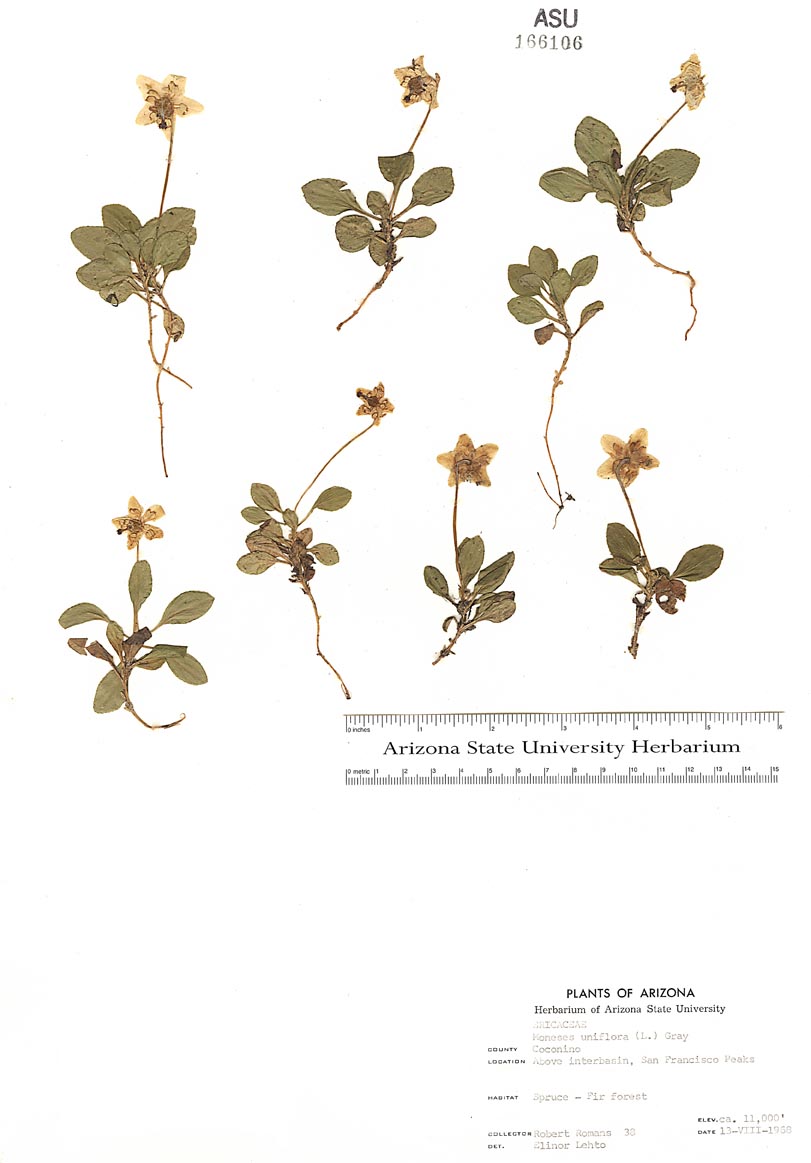Moneses
|
Family: Ericaceae |
Herbs, chlorophyllous, autotrophic. Stems erect, glabrous or papillose distally. Leaves cauline, sometimes appearing basal, alternate or pseudoverticillate in 1-4 whorls; petiole present; blade not maculate, broadly elliptic to orbiculate, subcoriaceous, margins crenate-serrate to serrate, plane, surfaces glabrous. Inflorescences solitary flowers, not lax in bud or flower, erect in fruit; peduncular bracts present or absent. Pedicels absent. Flowers radially symmetric, spreading or nodding; sepals 5, connate proximally, often obscurely so, calyx lobes ovate to narrowly ovate; petals 5, distinct, creamy white, without basal tubercles, corolla rotate to broadly campanulate; intrastaminal nectary disc absent; stamens 10, included; filaments broad proximally, gradually narrowed medially, slender distally, glabrous; anthers oblong, without awns, with tubules, dehiscent by 2 round pores; pistil 5-carpellate; ovary imperfectly 5-locular; placentation intruded-parietal; style (exserted), straight, expanded distally; stigma 5-lobed, without subtending ring of hairs. Fruits capsular, erect, dehiscence loculicidal, no cobwebby tissue exposed by splitting valves at dehiscence. Seeds ca. 1000, fusiform, winged. x = 11, 12, 13, 16. PLANT: Perennial scapose herb with slender rhizome-like root. LEAVES: in basal rosette; blades ovate, elliptic to obovate, 1-2.5 cm long; apex rounded; bases partly decurrent; teeth small, rounded; petiole generally shorter than blade. Scapes to 8 cm tall. FLOWER: single, actinomorphic, drooping; sepals ovate, about 3 mm long, the apex rounded, the margins fringed; petals waxy-white to pinkish, widely spread, entire or minutely fringed, without basal tubercles on upper side; filaments tapered from base, glabrous; anthers with prominent tubes and pores, the sacs about 3 mm long; pollen in tetrads; style straight; stigmatic lobes 5, prominent and marginal. FRUIT: an erect globose capsule without fibers connecting the opened valves. NOTES: A monotypic genus with a wide distribution in the Northern Hemisphere. (Greek: monos = single + hesis = delight; in reference to the single flower). REFERENCES: Haber, Erich. 1992. Pyrolaceae. Ariz.-Nev. Acad. Sci. 26(1)2. Pet 5; filaments slender, slightly widened near the base; anthers subapically attached, the pollen-sacs narrowed above the filament and each with an apical pore; ovary subglobose, concave at the top; style well developed; stigma peltate, with 5 erect marginal lobes; capsule subglobose, opening from the top down; delicate perennial from slender creeping roots, with 1-4 sets of deciduous, opposite or ternate lvs near the base; fls white, solitary, terminal, nodding, long-peduncled. Monospecific. Gleason, Henry A. & Cronquist, Arthur J. 1991. Manual of vascular plants of northeastern United States and adjacent Canada. lxxv + 910 pp. ©The New York Botanical Garden. All rights reserved. Used by permission. |

